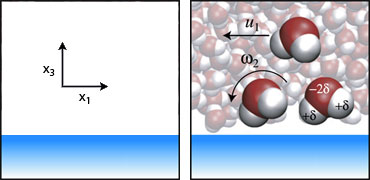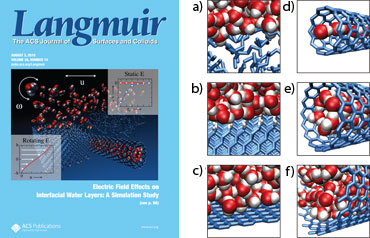Exploiting water's polarity for electrokinetic pumping at aqueous interfaces
Efficiently transporting fluid on the nanometre scale is a challenge
faced in biology and nanofluidic technology alike.
An advantage of the small length scales involved is that interfaces are
abundant and fluid flow can be driven by surface effects, such as
electro-osmosis.
However, electro-osmosis requires mobile charge carriers, for which it
is often energetically unfavourable to enter nanofluidic channels.
We show that pumping of water without mobile ions can be achieved by
injecting torque into the liquid, based on the coupling between
molecular spinning and fluid vorticity.
Water molecules have a highly anisotropic electronic structure, with the two hydrogen atoms carrying a net positive charge and the oxygen atom being negatively charged. To study the effect of this anisotropy on electrokinetic flow, we generalise the Navier-Stokes equations to include the effects of water spinning, dipole orientation and relaxation. We show analytically that pumping of a dipolar liquid through an uncharged nanofluidic channel can be achieved by injecting torque into the liquid, exploiting the coupling between molecular spin and fluid vorticity. Pumping is possible continuously, using rotating electric fields and suitably chosen interfacial boundary conditions, or transiently, by suddenly switching on a homogeneous electric field [1,2]. This electrohydraulic power conversion offers a new alternative for pumping mechanisms in nanodevices. A static electric field, however, does not induce a steady-state flow in channels, irrespective of the geometry [3,4]. See also this Physics highlight.
Likewise, the electrophoretic mobility of neutral solutes, such as oil droplets and air bubbles, in pure water has been a highly debated topic for over a century. Conventional theory states that a non-zero electrophoretic mobility cannot exist without mobile charged species present, but the polarity of water molecules is typically not included in the analysis. Using the same hydrodynamic framework, we show that the polar water ordering does not contribute to the electrophoretic mobility of neutral solutes [2]. Charge transfer between water molecules, on the other hand, may a make marginal contribution [5].

In a different setup, we show that pure water can also be transported using oscillating and phase-shifted electric fields by means of a polarization-dragging mechanism. Using molecular dynamics simulations and analytical theory, we study a system consisting of a carbon nanotubes with electrodes on the outside, carrying charges oscillating with frequencies in the gigahertz regime. The oscillating charges produce a polarization wave in the water, dragging water molecules along [6].

Water molecules have a highly anisotropic electronic structure, with the two hydrogen atoms carrying a net positive charge and the oxygen atom being negatively charged. To study the effect of this anisotropy on electrokinetic flow, we generalise the Navier-Stokes equations to include the effects of water spinning, dipole orientation and relaxation. We show analytically that pumping of a dipolar liquid through an uncharged nanofluidic channel can be achieved by injecting torque into the liquid, exploiting the coupling between molecular spin and fluid vorticity. Pumping is possible continuously, using rotating electric fields and suitably chosen interfacial boundary conditions, or transiently, by suddenly switching on a homogeneous electric field [1,2]. This electrohydraulic power conversion offers a new alternative for pumping mechanisms in nanodevices. A static electric field, however, does not induce a steady-state flow in channels, irrespective of the geometry [3,4]. See also this Physics highlight.
Likewise, the electrophoretic mobility of neutral solutes, such as oil droplets and air bubbles, in pure water has been a highly debated topic for over a century. Conventional theory states that a non-zero electrophoretic mobility cannot exist without mobile charged species present, but the polarity of water molecules is typically not included in the analysis. Using the same hydrodynamic framework, we show that the polar water ordering does not contribute to the electrophoretic mobility of neutral solutes [2]. Charge transfer between water molecules, on the other hand, may a make marginal contribution [5].

Fig. 1. Illustration of the mechanism to induce electrohydraulic flow in a
dipolar fluid.
The rotating electric field exerts a torque on the oriented dipoles of the water, leading to rotation ω2.
The rotation is coupled to the velocity u1 via the antisymmetric part of the stress tensor.
However, a static electric field does not lead to fluid flow.
In a different setup, we show that pure water can also be transported using oscillating and phase-shifted electric fields by means of a polarization-dragging mechanism. Using molecular dynamics simulations and analytical theory, we study a system consisting of a carbon nanotubes with electrodes on the outside, carrying charges oscillating with frequencies in the gigahertz regime. The oscillating charges produce a polarization wave in the water, dragging water molecules along [6].

Substrates used for the molecular dynamics simulations: (a) oil, (b) diamond, (c) graphene, (d-f) carbon nanotubes.
Cover image source: American Chemical Society.
| [1] | D. J. Bonthuis, D. Horinek, L. Bocquet and R. R. Netz; Electrohydraulic power conversion in planar nanochannels; Phys. Rev. Lett. 103, 144503 (2009). | |
| [2] | D. J. Bonthuis, D. Horinek, L. Bocquet and R. R. Netz; Electrokinetics at aqueous interfaces without mobile charges; Langmuir 26, 12614 (2010). | |
| [3] | D. J. Bonthuis, K. Falk, C. N. Kaplan, D. Horinek, A. N. Berker, L. Bocquet and R. R. Netz; Comment on "Pumping of confined water in carbon nanotubes by rotation-translation coupling"; Phys. Rev. Lett. 105, 209401 (2010). | |
| [4] | D. J. Bonthuis, K. F. Rinne, K. Falk, C. N. Kaplan, D. Horinek, A. N. Berker, L. Bocquet and R. R. Netz; Theory and simulations of water flow through carbon nanotubes: Prospects and pitfalls; J. Phys.: Condens. Matter 23, 184110 (2011). | |
| [5] | R. Vachá, O. Marsalek, A. P. Willard, D. J. Bonthuis, R. R. Netz and P. Jungwirth; Charge transfer between water molecules as the possible origin of the observed charging at the surface of pure water; J. Chem. Phys. Lett. 3, 107 (2012). | |
| [6] | K. F. Rinne, S. Gekle, D. J. Bonthuis and R. R. Netz; Nanoscale pumping of water by AC electric fields; Nano Lett. 12, 1780 (2012). | |